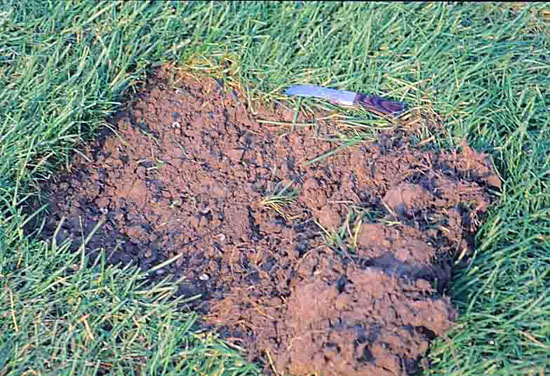Issue 17, October 22, 2013
White Grubs
The drought of 2012 and reduced irrigation of turf during that time greatly reduced the emergence of Japanese beetle adults and production of associated grubs this year. Masked chafers are influenced less by dry weather, and their grubs are present, generally in relatively low numbers. I have seen infestations and received reports of infestations at levels of two to four grubs per square foot This is far below the ten to twelve per square foot that are likely to do enough root feeding to cause turf wilting and dieback. However, it is common for birds, skunks, raccoons, and armadillos to tear up the turf to feed on three to four grubs per square foot. Mammal damage has been reported with as few as one grub per square foot.
Check for grub numbers by cutting through the turf with a heavy knife and pulling back the turf. In moist turf, the grubs will be in the root zone and easily seen. Some may be hanging in the sod, but most will be on the soil surface that is exposed when the sod is pulled back. Till the soil lightly with the knife to determine if additional grubs are present in the upper couple of inches of soil. If the soil is dry, till the soil four to six inches deep to check for grubs. The soil fractures along the grubs' bodies, causing them to pop up to the surface where they are easily seen and counted.

A single skunk will make 100 or so holes in one night looking for grubs. The round holes will be about three inches across and just through the sod. Raccoons pull back four to twelve inch sheets of sod to expose the grubs. Armadillos will dig several holes several inches deep and several inches across. Armadillos have been found throughout the state, but are most common in the southern third. Birds scratch away the turf and soil to expose grubs. None of these animals replace their divots, making their biological control services in eating the grubs much less important than the turf they destroy in the process.
White grub populations at this time of year can be controlled with an application of trichlorfon (Dylox), chlorantroniliprole (Acelepryn), or Heterorhabditis bacteriophora nematodes. Each should be watered in soon after application. (Phil Nixon)
Author:
Phil Nixon